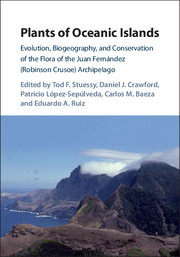 Plants of Oceanic Islands
Plants of Oceanic Islands Book contents
- Plants of Oceanic IslandsEvolution, Biogeography, and Conservation of the Flora of the Juan Fernández (Robinson Crusoe) Archipelago
- Frontispiece
- Plants of Oceanic Islands
- Copyright page
- In Memoriam
- Dedication
- Miscellaneous Frontmatter
- Contents
- Contributors
- Preface
- Acknowledgments
- Introduction
- Part I Historical Aspects
- Part II Physical Setting
- Part III The Green Landscape
- Part IV Plant Conservation
- Part V Patterns of Character Diversity
- Part VI Evolutionary Processes
- Part VII Biogeography
- Conclusions
- Appendices
- Literature Cited
- Index of Scientific and Vernacular Names
- Index of Topics
- References
Literature Cited
Published online by Cambridge University Press: 13 October 2017
- Plants of Oceanic IslandsEvolution, Biogeography, and Conservation of the Flora of the Juan Fernández (Robinson Crusoe) Archipelago
- Frontispiece
- Plants of Oceanic Islands
- Copyright page
- In Memoriam
- Dedication
- Miscellaneous Frontmatter
- Contents
- Contributors
- Preface
- Acknowledgments
- Introduction
- Part I Historical Aspects
- Part II Physical Setting
- Part III The Green Landscape
- Part IV Plant Conservation
- Part V Patterns of Character Diversity
- Part VI Evolutionary Processes
- Part VII Biogeography
- Conclusions
- Appendices
- Literature Cited
- Index of Scientific and Vernacular Names
- Index of Topics
- References
- Type
- Chapter
- Information
- Plants of Oceanic IslandsEvolution, Biogeography, and Conservation of the Flora of the Juan Fernández (Robinson Crusoe) Archipelago, pp. 381 - 383Publisher: Cambridge University PressPrint publication year: 2017
